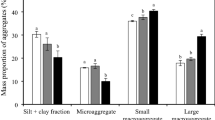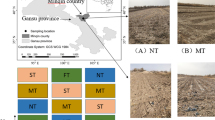Abstract
Soil enzyme activities are closely associated with soil organic carbon (SOC) or microbial biomass carbon (MBC). High correlation between SOC and MBC masks their individual effects on enzyme activities. Expressing soil enzymes activity relative to soil organic carbon (SOC) or Microbial Biomass Carbon (MBC) would normalize the differences in SOC/MBC. A long term subtropical rice-wheat system was selected to study the variation in soil-specific enzyme activity (per unit SOC and MBC) in soil aggregates under integrated nutrient management. Soil organic carbon, microbial biomass carbon and the enzyme activities like acid phosphatase (ACP), alkaline phosphatase (AKP), dehydrogenase (DHA), fluorescien diacetate hydrolysing capacity (FDA) and urease were measured in three aggregate size fractions viz., >2000, 2000–250 and <250 µm. Integrated nutrient management practices significantly increased the specific enzyme activities expressed in relation to SOC and MBC. Aggregate size fractions of 2000–250 µm size exhibited higher specific enzyme activities, when expressed in terms of SOC. Enzyme activity (per unit MBC) in aggregates also followed the same pattern with an exception to dehydrogenase activity which was almost uniform across all the aggregates size fractions. Aggregates of larger size do not always possess higher enzymes activity; even smaller macroaggregates were able to retain stable extracellular enzyme activity per unit of SOC or MBC. This study opens an alley to express soil enzymatic activities relative to SOC or MBC level in the soils, rather than expressing absolute activities.





Similar content being viewed by others
DATA AVAILABILITY
The primary data is available with the corresponding author and can be shared, if so needed.
REFERENCES
W. Ali, M. Nadeem, W. Ashiq, M. Zaeem, S. S. M. Gilani, S. Rajabi-Khamseh, T. H. Pham, V. Kavanagh, R. Thomas, and M. Cheema, “The effects of organic and inorganic phosphorus amendments on the biochemical attributes and active microbial population of agriculture podzols following silage corn cultivation in boreal climate,” Sci. Rep. 9, 17297 (2019). https://doi.org/10.1038/s41598-019-53906-8
S. D. Allison and J. D. Jastrow, “Activities of extracellular enzymes in physically isolated fractions of restored grassland soils,” Soil Biol. Biochem. 38 (11), 3245–3256 (2006). https://doi.org/10.1016/j.soilbio.2006.04.011
V. J. Allison, L. M. Condron, D. A. Peltzer, S. J. Richardson, and B. L. Turner, “Changes in enzyme activities and soil microbial community composition along carbon and nutrient gradients at the Franz Josef chronosequence, New Zealand,” Soil Biol. Biochem. 39 (7), 1770–1781 (2007). https://doi.org/10.1016/j.soilbio.2007.02.006
A. Beheshti, F. Raiesi, and A. Golchin, “Soil properties, C fractions and their dynamics in land use conversion from native forests to croplands in northern Iran,” Agric., Ecosyst. Environ. 148, 121–133 (2012). https://doi.org/10.1016/j.agee.2011.12.001
C. J. Bronick and R. Lal, “Soil structure and management: a review,” Geoderma 124, 3–22 (2005). https://doi.org/10.1016/j.geoderma.2004.03.005
G. Csitari, Z. Tóth, and M. Kökény, “Effects of organic amendments on soil aggregate stability and microbial biomass in a long-term fertilization experiment (Iosdv),” Sustainability 13, 9769 (2021). https://doi.org/10.3390/su13179769
A. Das, R. P. Sharma, N. Chattopadhyaya, and R. Rakshit. “Yield trends and nutrient budgeting under a long-term (28 years) nutrient management in rice-wheat cropping system under subtropical climatic condition,” Plant Soil Environ. 60, 351–357 (2014). https://doi.org/10.17221/46/2014-PSE
R. P. Dick, “Soil enzyme activities as indicators of soil quality,” in Defining Soil Quality for a Sustainable Environment, Ed. by J. W. Doran, D. C. Coleman, D. F. Bezdicek, and B. A. Stewart (Am. Soc. Agron., 1994), pp. 107–124. https://doi.org/10.2136/sssaspecpub35.c7
X. Ding and X. Han, “Effects of long-term fertilization on contents and distribution of microbial residues within aggregate structures of a clay soil,” Biol. Fertil. Soils 50, 549–554 (2014). https://doi.org/10.1007/s00374-013-0867-6
E. T. Elliott and D. C. Coleman, “Let the soil work for us,” Ecol. Bull. 39, 23–32 (1988). https://www.jstor.org/stable/20112982
V. S. Green, D. E. Stott, and M. Diack, “Assay for fluorescein diacetate hydrolytic activity: optimization for soil samples,” Soil Biol. Biochem. 38, 693–701 (2006). https://doi.org/10.1016/j.soilbio.2005.06.020
K. A. Gomez and A. A. Gomez, Statistical Procedures for Agricultural Research (John Wiley & Sons, New York, 1984).
J. D. Jastrow, J. E. Amonette, and V. L. Bailey, “Mechanisms controlling soil carbon turnover and their potential application for enhancing carbon sequestration,” Clim. Change 80 (1–2), 5–23 (2007). https://doi.org/10.1007/s10584-006-9178-3
D. A. Klein, T. C. Loh, and R. L. Goulding, “A rapid procedure to evaluate dehydrogenase activity of soils low in organic matter,” Soil Biol. Biochem. 3, 385–387 (1971). https://doi.org/10.1016/0038-0717(71)90049-6
D. Kumar, R. Rakshit, R. Rani, P. Bharti, A. Das, and M. Kundu, “Integrated nutrient management in coconut (Cocos nucifera L.): an assessment of soil chemical and biological parameters under subtropical humid climate,” J. Soil Sci. Plant Nutr. 22, 2695–2706 (2022). https://doi.org/10.1007/s42729-022-00837-5
R. Kumari, M. Kundu, A. Das, R. Rakshit, S. Sengupta, S. Sahay, and F. Ahmad, “Long term integrated nutrient management improves carbon stock and fruit yield in a subtropical mango (Mangifera indica L.) orchard,” J. Soil Sci. Plant Nutr. 20, 725–737 (2020). https://doi.org/10.1007/s42729-019-00160-6
Y. Kuzyakov, “Priming effects: interactions between living and dead organic matter,” Soil Biol. Biochem. 42, 1363–1371 (2010). https://doi.org/10.1016/j.soilbio.2010.04.003
A. Lagomarsino, A. Benedetti, S. Marinari, L. Pompili, M. C. Moscatelli, P. P. Roggero, R. Lai, L. Ledda, and S. Grego, “Soil organic C variability and microbial functions in a Mediterranean agro-forest ecosystem,” Biol. Fertil. Soils 47, 283–291 (2011). https://doi.org/10.1007/s00374-010-0530-4
L. Landi, G. Renella, J. L. Moreno, L. Falchini, and P. Nannipieri, “Influence of cadmium on the metabolic quotient, l-:d-glutamic acid respiration ratio and enzyme activity: microbial biomass ratio under laboratory conditions,” Biol. Fertil. Soils 32, 8–16 (2000). https://doi.org/10.1007/s003740000205
M. E. Malobane, A. D. Nciizah, F. N. Mudau, and I. I. Wakindiki, “Tillage, crop rotation and crop residue management effects on nutrient availability in a sweet sorghum-based cropping system in marginal soils of South Africa,” Agronomy 10 (6), 776 (2020). https://doi.org/10.3390/agronomy10060776
P. Nannipieri, L. Giagoni, G. Renella, E. Puglisi, B. Ceccanti, G. Masciandaro, F. Fornasier, M. C. Moscatelli, and S. Marinari, “Soil enzymology: classical and molecular approaches,” Biol. Fertil. Soils 48, 743–762 (2018). https://doi.org/10.1007/s00374-012-0723-0
P. Nannipieri, E. Kandeler, and P. Ruggiero, “Enzyme activities and microbiological and biochemical processes in soil,” in Enzymes in the Environment: Activity, Ecology and Applications, Ed. by R. G. Burns and R. P. Dick (Marcel Dekker, New York, 2002), pp. 1–33.
J. H. Quastel, Soil Metabolism (The Royal Institute of Chemistry of Great Britain and Ireland, London, 1946).
F. Raiesi and A. Behesti, “Soil specific enzyme activity shows more clearly soil responses to paddy rice cultivation than absolute enzyme activity in primary forests of northwest Iran,” Appl. Soil Ecol. 75, 63–70 (2014). https://doi.org/10.1016/j.apsoil.2013.10.012
R. Rakshit, A. Das, R. Padbhushan, R. P. Sharma, Sushant, and S. Kumar, “Assessment of soil quality and identification of parameters influencing system yield under long-term fertilizer trial,” J. Indian Soc. Soil Sci. 66, 166–171 (2018). https://doi.org/10.5958/0974-0228.2018.00021.X
C. Singh, R. Rakshit, A. Das, and P. Bharti, “Interpretations of elemental and microbial phosphorus indicators to understand P availability in soils under rice–wheat cropping system,” Agric. Res. 9, 329–339 (2020). https://doi.org/10.1007/s40003-019-00439-1
M. A. Tabatabai and J. M. Bremner, “Use of p-nitrophenyl phosphate for assay of soil phosphatase activity,” Soil Biol. Biochem. 1, 301–307 (1969). https://doi.org/10.1016/0038-0717(69)90012-1
M. A. Tabatabai and J. M. Bremner, “Assay of urease activity in soils,” Soil Biol. Biochem. 4, 479–487 (1972). https://doi.org/10.1016/0038-0717(72)90064-8
E. D. Vance, P. C. Brookes, and D. S. Jenkinson, “An extraction method for measuring soil microbial biomass C,” Soil Biol. Biochem. 19 (6), 703–707 (1987). https://doi.org/10.1016/0038-0717(87)90052-6
M. P. Waldrop, T. C. Balser, and M. K. Firestone, “Linking microbial community composition to function in a tropical soil,” Soil Biol. Biochem. 32, 1837–1846 (2000). https://doi.org/10.1016/S0038-0717(00)00157-7
A. J. Walkley and I. A. Black, “An examination of Degtjareff method for determining soil organic matter and a proposed modification of the chromic acid titration method,” Soil Sci. 37 (1), 29–38 (1934). https://doi.org/10.1097/00010694-193401000-00003
B. Wang, S. Xue, G. B. Liu, G. H. Zhang, G. Li, and Z. P. Ren, “Changes in soil nutrient and enzyme activities under different vegetations in the Loess Plateau area, Northwest China,” Catena 92, 186–195 (2012). https://doi.org/10.1016/j.catena.2011.12.004
Y. Wang, N. Hu, T. Ge, Y. Kuzyakov, Z-L. Wang, Z. Li, Z. Tang, Y. Chen, C. Wu, and Y. Lou, “Soil aggregation regulates distributions of carbon, microbial community and enzyme activities after 23-year manure amendment,” Appl. Soil Ecol. 111, 65–72 (2017). https://doi.org/10.1016/j.apsoil.2016.11.015
H. Yu, W. Ding, J. Luo, R. Geng, and Z. Cai, “Long-term application of organic manure and mineral fertilizers on aggregation and aggregate-associated carbon in a sandy loam soil,” Soil Tillage Res. 124, 170–177 (2012). https://doi.org/10.1016/j.still.2012.06.011
P. Bharti, A. Das, S. R. Choudhury, S. Shambhavi, P. Ganguly, B. Bihari, S. Kumar, and R. Rakshit, “Soil aggregation controls biological activities on long-term integration of organic amendments and inorganic fertilizers in rice-wheat cropping system,” Commun. Soil Sci. Plant Anal. 54 (13), 1865–1876 (2023). https://doi.org/10.1080/00103624.2023.2211103
ACKNOWLEDGMENTS
The authors are heartily thankful to Hon’ble Vice Chancellor, Bihar Agricultural University (BAU), Sabour, Bhagalpur, India, for providing all the necessary facilities; Director of Research, BAU, Sabour for his continuous support and valuable suggestions.
Funding
This work was supported by the Bihar Agricultural University, PG Contingency grant.
Author information
Authors and Affiliations
Corresponding author
Ethics declarations
ETHICS APPROVAL AND CONSENT TO PARTICIPATE
This work does not contain any studies involving human and animal subjects.
CONFLICT OF INTEREST
The authors of this work declare that they have no conflicts of interest.
Additional information
Publisher’s Note.
Pleiades Publishing remains neutral with regard to jurisdictional claims in published maps and institutional affiliations.
Abbreviations: SOC—soil organic carbon; MBC—microbial biomass carbon; ACP—acid phosphatase; AKP—alkaline phosphatase; DHA—dehydrogenase activity; FDA—fluorescien diacetate hydrolysing capacity; FYM—farm yard manure; WS – wheat straw; GLM—green leaf manuring.
Rights and permissions
About this article
Cite this article
Bharti, P., Das, A., Kumar, S. et al. Assessment of Soil Specific Enzyme Activities in Aggregates Size Fractions: a Case Study from Subtropical Agro-ecosystem. Eurasian Soil Sc. 57, 646–656 (2024). https://doi.org/10.1134/S1064229323602627
Received:
Revised:
Accepted:
Published:
Issue Date:
DOI: https://doi.org/10.1134/S1064229323602627




